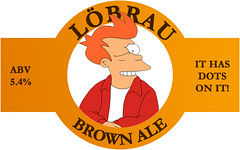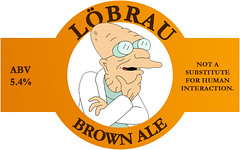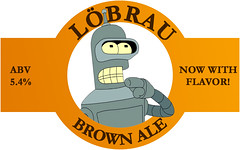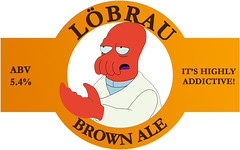After nearly a month of conditioning1 in the cellar, the latest batch of homebrew is just about ready for consumption. I'll give the first bottle a taste this weekend, to see how well it's coming along, though I suspect it'll have a noticeable improvement by next weekend, and won't hit its peak for a few weeks after that. By Thanksgiving, it ought to be as balanced as it's going to get.
For now, though, I'll take the opportunity to affix some labels to this batch. I've been toying with the notion of using a variety of labels on a single batch, a sort of "Collect Them All!" group like you see on kids' cereal boxes. The first idea was to do this with embarrassing pictures of friends and invite them all over for a summer barbecue. Good layout ideas never materialized, and I was too busy to get a batch done in time, so that batch'll be on hiatus. Besides, a barbecue calls for something not too sweet, with a good hop backbone2, and the previous two batches had been just that: Brickies Best Bitter and the ITMFA IPA.
This beer is a brown ale, spiked with a little cinnamon. My hope is that it'll lend a slight spiciness that can't quite be identified, but we'll see. Otherwise, it's a mix of amber and pale malt extracts, some crystal and chocolate malts, and Centennial and Cascade hopes for bitterness and aroma, respectively. As for the yeast, here's what Wyeast has to say about it:
Wyeast Labs 1338 European Ale Yeast. From Wissenschaftliche in Munich. Full-bodied complex strain finishing very malty with full bodied profile, very desirable in English Style Brown Ales and Porters. Produces a dense, rocky head during fermentation. Flocculation - high; apparent attenuation 67-71%. (62-72° F, 16-22° C)The brewers' jargon in there means:
- Flocculation - Refers to the clumping behavior of the yeast. More flocculant yeasts will tend to stick together once they've finished their eat/reproduce/etc. cycle, and settle to the bottom of the fermenting vessel. This results in a brighter - meaning clearer, with less haze - beer, which is desirable in some styles. This beer ought to be dark enough that brightness isn't a real concern, like it would be in a pale ale, say.
- Attenuation - Refers to how much of the available sugar the yeast will devour before going dormant. I've always used 75% as my initial estimate, which produces a reasonably dry ale. Lower ranges make for sweeter, less alcoholic beers, and these often have more body because of the dissolved sugars.3
- Produces a dense, rocky head during fermentation - Ale yeasts tend to congregate at the top of the fermenting vessel, which you can see if you're fermenting in glass, or pop the top off the container to have a look inside. I try to avoid both of those options. A primary fermentation in glass runs the risk of breaking the glass if the pressure builds too high; exposing the wort to air increases the risk of infection, which could cause anything from bizarre off-flavors to exploding bottles. Though the yeast stops short of fermenting all of the available sugars, wild bacteria have no such qualms. That said, I did get a look at the head on this beer when I transferred from the first fermenting vessel to a secondary glass fermenter, and it was pretty neat.
I'd thought about labels for this beer, and there weren't any particular visual elements that jumped out at me. Well, I couldn't stop thinking about the New Glarus 'Fat Squirrel' nut brown ale, which meant that I had to avoid any and all animal-themed labels. There weren't even any bad puns coming to mind, so I went with a backup I'd been tossing around for a while: LöBrau.
On "Futurama", the creative staff made a serious effort to populate their imaginary world with all sorts of made-up products, most of which sound both hilarious and repulsive. Slurm, the ubiquitous soft drink. Bachelor Chow, which is basically dog food marketed to single men. That sort of thing. Of all of the products shown, I'm only aware of one that was mistakenly included in both the year 2000 and the year 3000: LöBrau beer. Fry is shown drinking it when he falls into the cryogenic freezer, but then is shown drinking it on a regular basis, a thousand years later.
Talk about a brand with some serious staying power.
So, in that spirit, I've drawn up four different labels for this new beer, all based on Futurama. Each features a major character, with a little tagline from the show that applies - at least sort of - to the beer, even if it was in another context.

Philip J. Fry's the hero of the show, a lazy, shiftless delivery boy who is accidentally frozen in the year 2000 and wakes up a thousand years later. In one episode, when the crew is trying to decide what kind of beer to buy, Fry holds up a six-pack of LöBrau, and says, "How about LöBrau? It has dots on it." Like when Moe Szyslak, the "Simpsons" bartender, convinces Homer to pay extra for imported beer by using a marker to turn 'Duff' into 'Düff'.

Professor Hubert J. Farnsworth, Fry's great-great-whatever-nephew, is a doddering old man who's half mad scientist. He just runs an interstellar package delivery service to pay the bills. "Not a Substitute for Human Interaction" is one of the opening credit subtitles, a joke that changes with every show. Other favorites of mine include: "Painstakingly Drawn Before A Live Audience"; "80% Entertainment by Volume"; and "When You See the Robot, Drink!", which was another potential label option.

Bender Bending Rodriguez is Fry's best friend and roommate, an alcoholic, cigar-smoking, foul-mouthed robot whose primary goal is to do everything illegal he possibly can. In the future, robots need alcohol as a power source, so Bender acts like a drunk whenever he hasn't had enough to drink. "Now With Flavor!" is a slogan for Bachelor Chow, which looks to be more or less like dog food, only marketed to single losers, like Fry. The other Bachelor Chow slogan, not surprisingly, is "Makes Its Own Gravy!"

Dr. John Zoidberg is the doctor for Planet Express, despite the fact that he's completely unfamiliar with human anatomy. Unless it's something he's seen on a decongestant commercial. "It's Highly Addictive!" is the slogan of Slurm, the utterly disgusting and exceedingly popular soft drink in the year 3000. It's so addictive that Fry, upon learning its secret (and only) ingredient, doesn't stop drinking it.
* * * * *
1I.e., sitting in the bottles, ideally not exploding from the carbonation process. The yeast converts any remaining sugars - including a little dextrose added to ensure carbonation - into alcohol and carbon dioxide. While waiting for this to happen, plus another two or three weeks, the 'green' flavors of the beer dissipate.
2Or something crisp, in the lager/pilsner vein, but I don't have the facilities for beers made with lager yeasts. Perhaps I'll invest in a spare refrigerator someday, but until then, it's ales all the way. I prefer the fruity aromas af ale yeasts, anyhow.
3Unfermentable sugars, such as lactose and those found in crystal malts, are a great way to give body to beer without an overwhelming sweetness, since they provide a less sweet sensation than, say, sucrose.

No comments:
Post a Comment